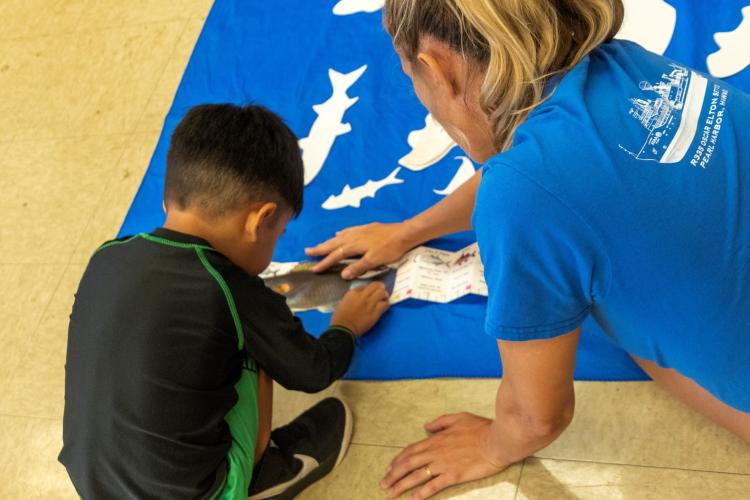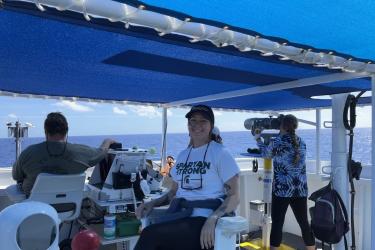“Spicy ‘ahi!” “Shoyu!” “Limu!”
When asked about their favorite type of poke, it’s clear that Hawai‘i keiki of all ages have a lot of opinions. They’re also huge fans of fish!
October is National Seafood Month, and in Hawai‘i, seafood is all around us. We eat more seafood per capita than any other state. NOAA Fisheries uses science and protection measures to ensure there will be enough fish around for future generations. We also help the next generation learn about this work—and how they can support sustainable seafood at home. This October, our Pacific Islands Regional Office and Science Center staff partnered with a few youth fall break programs to show how NOAA studies and manages fisheries. Let’s take a photo journey through the activities!
Under the Microscope: The Science of Aging Fish
Hawaiʻi fisheries extension agent and NOAA affiliate Alex Filardo taught students about the importance of studying fish age and growth rates. NOAA Fisheries scientists rely on this information to better monitor, assess, and manage fish populations.
One of the main ways we age fish is by using otoliths, or fish ear stones or ear bones. Throughout a fish’s life, otoliths grow new material around a core. The layers that grow each year can be counted under a microscope like counting rings on a tree.
“Seeing the growth patterns on fish otoliths connects students with an interesting natural phenomenon that they typically have never seen … and understanding how we can use that info across populations demonstrates how rules, like minimum sizes for harvest, are directly tied to science.” — Celeste Hanley, education and outreach specialist
Minimum Catch Sizes Relay
Fishery management specialist Keith Kamikawa and education coordinator and NOAA affiliate Ali Bayless help keiki identify and measure fish in a relay game about minimum catch sizes. Minimum size rules for harvesting ensure that enough fish are growing into reproductive adults to sustain their populations.
In the relay game, students carefully inspect the measurement guide to ID the species of fish they “caught” and measure its length.
If it meets the minimum criteria for that species, it’s a keeper, and they head back to their line. If it’s too small, they “release” it so it can grow!
“When kids understand that [rules like] minimum sizes help support our fish populations and protect our fishing traditions, they’re eager to make sure that they’re abiding by them. They’re also excited to tell friends and family members about it.” – Keith Kamikawa, fishery management specialist
Fisheries Observers: NOAA’s Eyes on the Seas
Cooperative programs specialist Victoria Dodd and outreach and education specialist Celeste Hanley helped keiki learn about the role of fisheries observers in sustainable fisheries management. Keiki stepped into the role of an observer aboard a vessel in the Hawai‘i longline fishery, collecting catch, bycatch, and protected species data on a mock fishing trip.
The activity also helped youth understand the species Hawai‘i longline fleets target and the rules that NOAA makes to minimize the impacts to protected species, including sea turtles, whales, and dolphins.
For example, if the fleet of swordfish vessels reaches the hard cap set for interactions with sea turtles, NOAA Fisheries actually closes the swordfish fishery for the remainder of the year. This ensures that the effort to put fresh swordfish on our plates can be achieved without compromising the future for endangered sea turtles.
“It was great to see students of all ages get excited to learn about the way a fishing vessel operates and its direct connection to the seafood they eat … and also that our local longline fleet is held to these [management] standards.” – Tori Dodd, cooperative programs specialist
Promoting Local, Sustainable Seafood
Fisheries observer and NOAA affiliate Lauren McGovern, communications assistant and NOAA affiliate Sarah Hutchinson, and outreach and education specialist Celeste Hanley ran button-making stations for keiki to bring the sustainable seafood message home—and into the grocery store!
Keiki picked out a few of their favorite fish designs featuring Hawai‘i-caught species and consulted a poster for inspiration on coloring them.
After coloring their designs, they placed them in the button-making machine to transform their work into a piece of wearable art or a magnet!
Sustainable options are all around us, if we look at the label. You won’t see seafood in the grocery store labeled as Hawai‘i-caught, but looking for “United States,” “U.S.,” or “U.S.A.” on the label is something everyone can do to find seafood backed by NOAA science and regulations. Choosing these products ensures that our dollars are not only supporting a delicious and nutritious meal, but also science-based stewardship of our oceans.
“We want the next generation [in Hawai‘i] to understand that you get what you pay for when you buy fresh poke [versus frozen]. You’re not only getting a better product and supporting our local economy, but also supporting sustainable fishing.” – Celeste Hanley, outreach and education specialist
NOAA’s Commitment to Education
NOAA Fisheries is committed to working with youth, educators, community groups, and other organizations to provide educational opportunities throughout the year in the Pacific Islands region. We are available for presentations and community events to showcase our ocean stewardship mission. If you are interested in requesting support for your event, fill out our outreach support request form.













